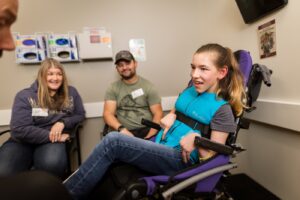A cross-state partnership in pediatric care

At a glance
- Mary Bridge Children’s Hospital and Shriners Children’s Spokane have teamed up to increase access
- Mary Bridge Children’s providers travel to Spokane multiple times a month to see patients
- Partnership fills critical gap in services for families who had been traveling for care
At her first trip to Shriners Children’s Spokane, 16-year-old Taylor Williams was cared for by a team of providers from multiple hospitals. She has cerebral palsy and scoliosis, experiences regular seizures, and has used a power wheelchair her entire life, explains her mother, Sarah Williams.
During this appointment, she was seen by her care team, including pediatric orthopedic surgeon Bryan Tompkins, MD, from Shriners Children’s Spokane Hospital, and John “Forrest” Bennett, ARNP, physical medicine and rehabilitation provider from Mary Bridge Children’s Hospital.
The collaborative appointment stems from a partnership between the two organizations aimed at filling a gap in regional pediatric care.
The Williams family lives in Yakima and previously had to travel to Tacoma to see Bennett every six to eight months, Sarah Williams explains. She and her husband, Mark Williams, would take multiple days off work to make the appointments — a costly and often stressful experience.
When the family learned their daughter would need a spinal fusion, Bennett, who travels to Spokane to provide regular pediatric rehab care, referred them to Dr. Tompkins in Spokane — only a one-day trip away.
“Now it’s all in one place,” Sarah Williams says. “Having them collaborate together is so nice.”

Taylor Williams smiles at her Mary Bridge Children’s Hospital pediatric rehabilitation provider, John “Forrest” Bennett during an appointment at an appointment at Shriners Children’s Spokane.
The Williams, like many other families, were forced to make the cross-state journey for treatment because such specialized care is limited, especially in the Inland Northwest.
“There are no pediatric physical medicine and rehabilitation providers in Spokane,” explains Ted Sousa, MD, pediatric orthopedic surgeon for Shriners Children’s Spokane. “Possibly, the kids might not be getting the care at all, because the trip to Seattle or Tacoma is just too far, and frankly, there are just too many kids. Waitlists can be very long with some providers.”
But now, Mary Bridge Children’s is providing the glue to pull it all together locally, Bennett says.
Improving access, one month at a time
Bennett and Robert Cooper, MD — fellow Mary Bridge Children’s physical medicine and rehabilitation provider — visit the Spokane Shriners clinic each month to meet with patients.
The partnership began in September 2022 with monthly visits, but that quickly expanded to nearly six days a month once they realized how great the demand was.
On day one, 68 patients were on the waiting list, says Peter Brewer, administrator for Shriners Children’s Spokane.
Because of the high level of care and complexity of their cases, each appointment averages 45-60 minutes — meaning they can only see about 16 patients a week, says Bennett.
“We’ve also implemented a telehealth solution for the Mary Bridge providers to bridge the gap with children between visits to Shriners,” Brewer says. “Each month, these important Spokane clinics fill up, and we’re still working with a waitlist of children.”
Additionally, this partnership plays a big role in improving health equity for one of the most disadvantaged populations, Bennett adds.
“In terms of equity of care, let’s call attention to this as a win,” he says. “The number of patients in my population who have resigned themselves to not receiving care is painfully high.
“If you have the means, you’ll go find the solution,” he continues, “but there’s a ton who just accept their disability and don’t think there’s anything we can do.”
Team approach improves outcomes
The services Bennett and Dr. Cooper provide at the Spokane clinic range from medical tone management to equipment consultations, bracing, and coordination with physical, orthopedic and speech therapists, Dr. Sousa explains.
“Working with rehabilitation medicine has made me a better care provider for these children,” he says. “Although there is a lot of crossover between pediatric orthopedic surgery and pediatric rehabilitation … I think we bring different skill sets to the table.”
For example, there’s a correlation between muscle tone and the amount of deformity a child may develop, Dr. Sousa says. The hope is that with more tone management and rehabilitation care, some surgeries can be prevented and better outcomes are possible.

(Left to right) Chelsea Ashby, RN, Shriners Children’s Spokane care manager, Missy Martin, RN, Shriners Children’s Spokane outpatient services director, Robert Cooper, MD, Mary Bridge Children’s Hospital physical medicine and rehabilitation provider and Ted Sousa, MD, Shriners Children’s Spokane pediatric orthopedic surgeon discuss their patients in the clinic hallway between appointments
“It’s truly a collaborative team approach,” Brewer says. “Together, they coordinate efforts to develop an interdisciplinary customized treatment plan individualized to the child’s specific functional needs.”
The children they care for are living with spinal or brain injuries, cerebral palsy, other genetic conditions, and anything that may limit their physical ability, Bennett explains. The ultimate goal of both teams is to help their patients live a comfortable life and reach their potential through access to the specialized care they need.
For patients like Taylor Williams, her mother explains how great it is to see this team supporting her in that journey.
“Taylor lights up every room she enters,” she says.




